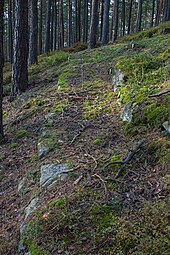Mirga
Mirga, also called Miga, Miega, Mocka, Mokka, was a Slavic settlement in what is now the Neustadt an der Waldnaab district (northern Upper Palatinate ).
geography
The settlement or city is said to have been on the ridge between Burkhardsreuth , Pichlberg and Barbaraberg . Some also speak of a spatial expansion via Eichelberg to Mockersdorf . Geographically, the high plateau slopes sharply to the south. There are the villages of Zettlitz , Schmierhütte and Seitenthal . The terrain is also very steep to the northwest. To the north and east, access was blocked by a swamp landscape shaped by the Haidenaab . So the place was best to defend. In addition, numerous sources of drinking water such as For example, the Neuhauser springs near Zettlitz, the small stream in the so-called Miega-Graben, the Hubbach and the Preißacher Mühlbach ensure the water supply and thus greatly facilitate settlement.
Today many field names still remind of this, and a forest section is also called Miega . Obvious remnants of this settlement can no longer be found apart from countless cuboid boulders .
history
In Slavic, I mean “farming community, community hallway, community meeting, masonry or dry stone wall, but also space, world and peace, peaceful, in peace”.
By chance, medieval burials were discovered in Barbaraberg in 1972, which were archaeologically investigated between 1992 and 1995. The remains of 297 people were documented in 161 graves, some of which were buried in wooden coffins and some in body bags. Almost all female deceased were typical S-loop rings of the Slavic women's costume of the 9th / 10th. Century, so that the ethno-cultural as well as the historical affiliation of the cemetery is guaranteed. The burial site from the Carolingian and Ottonian times is protected as a ground monument.
The existence of such a place was first mentioned in documents in the hall book of the Duchy of Bavaria from 1280, when Ludwig the Strict reigned. There it is said of a “Villa Mirga” in the “Ampte Eschenbach”.
The Amberg folklorist Franz Xaver Schönwerth wrote down stories, myths and legends that were passed down orally in the 19th century. The best-known legend that is still widespread among the population today is the following:
Found objects
Time and again, small horseshoes and square coins are found "on the Mirga" (this preposition is used by the locals).
literature
- Heimat Eschenbach, published by Heimatverein Eschenbach, 15th, 16th, 17th edition (1992, 1993 and 1994)
- 7th issue 1910 - Die Oberpfalz: home magazine for the former Bavarian Nordgau: the Upper Palatinate, the free imperial city of Nuremberg, the prince-bishopric of Eichstätt, Egerland and the adjacent areas; Verlag Michael Laßleben, Kallmünz / Regensburg; 1910
Web links
- Magdalena Wagner: giant city or place of worship? About the sunken city “Mirga” , Goethe-Institut Prague
- Stefan Groß: Mirga, a sunken city, video
Individual evidence
- ↑ Miegaberg on BayernAtlas Klassik
- ↑ Jan Zenit: Heimatbuch des Kreis Eschenbach . Ed .: Chronicle-Verlag Eschenbach. tape 1 . Chronik-Verlag Eschenbach, Eschenbach in der Oberpfalz 1950, p. 152 .
- ↑ Information board next to the church on Barbaraberg, authors: Ralf Schunk, Andreas Peterek, erected by Geozentrum KTB in 2006
- ↑ LfD list for Speinshart (.pdf)
Coordinates: 49 ° 46 ′ 51.5 ″ N , 11 ° 51 ′ 9 ″ E

